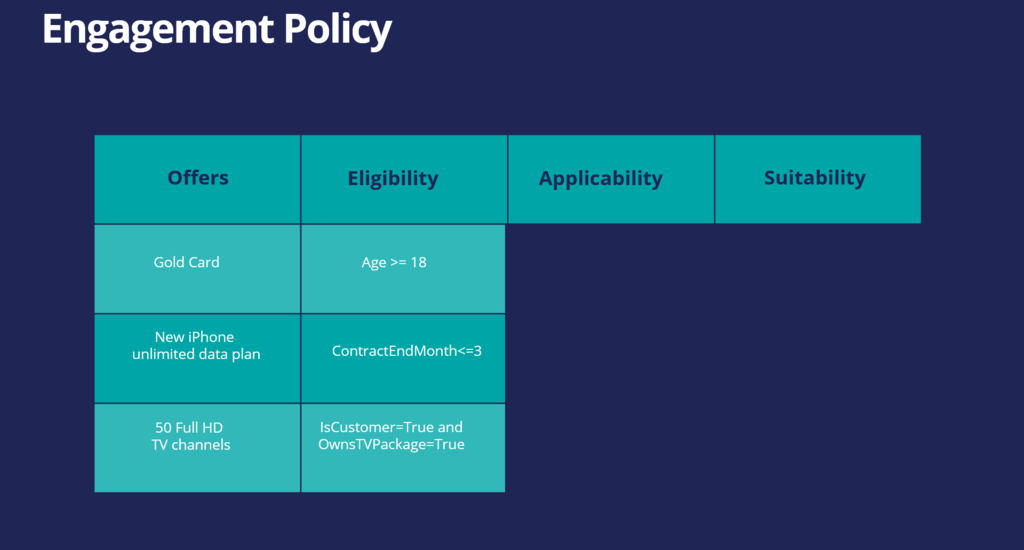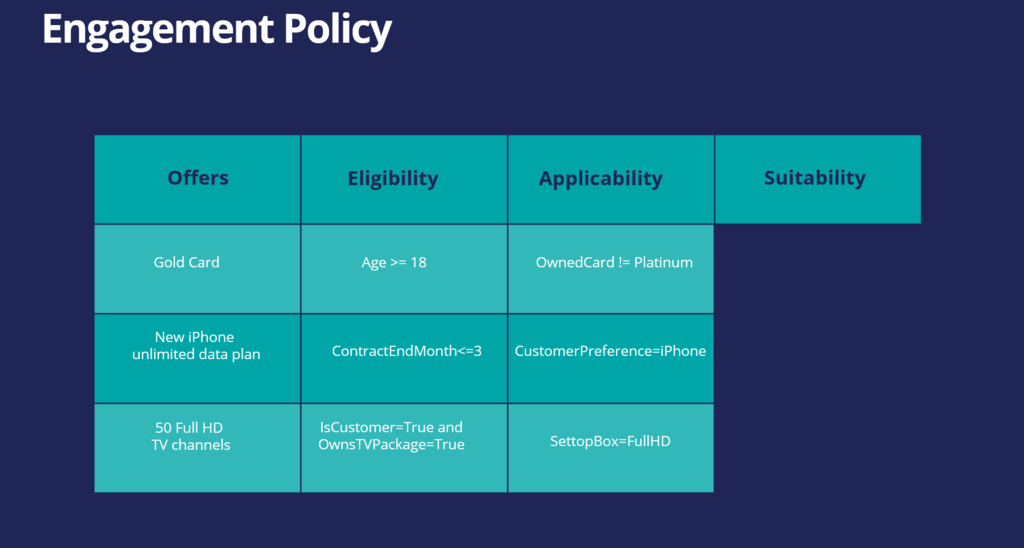
Customer engagement policies
Introduction
Engagement policies are a set of business rules and practices used by the organization to determine which customers are eligible for which Next-Best-Actions. These policies allow you to specify the conditions under which an action or group of actions are eligible for a customer.
Video
Transcript
This video explains the concept of customer engagement policies.
The Pega Customer Decision Hub™ combines analytics, business rules, customer data, and data collected during each customer interaction to create a set of actionable insights that it uses to make intelligent decisions. These decisions are known as the Next-Best-Action.
Every Next-Best-Action weighs customer needs against business objectives to optimize decisions based on priorities set by the business manager.
Typically, the business defines a set of rules that make certain actions available to certain customers. This set of rules is called an engagement policy.
As part of an engagement policy, three types of conditions are defined – Eligibility, Applicability, and Suitability.
Consider the following examples: a retail bank is promoting a Gold Credit Card; a telco is offering a new iPhone upgrade with an unlimited data plan; and a communications and media company is promoting a new bundle of HD channels.
Let’s see how to define engagement policy conditions that will ensure the bank’s Next-Best-Action decisions support these promotions.
In Eligibility, you define strict rules for what is legal, and even possible, to offer customers. For example, to be eligible for the Gold Card offer, customers must be 18 years or older.
Similarly, for the iPhone upgrade offer, customers are eligible for a new contract only if their old contract ends in less than three months.
For the TV channels offer, customers must already own a TV subscription. This offer is not available for customers who have only mobile or landline subscriptions.
In Applicability, you specify rules for limiting what to offer based on a customer’s current situation, which is often defined by the products they currently have. These rules are not as rigid as those for Eligibility.
For example, a Gold Card is not applicable if the customer already has a higher value card, such as a Platinum Credit Card. If a customer already has a Platinum Card, they might be eligible for the Gold Card, but the Gold Card is not applicable to them. If they ask for it, they may get it, but the business would prefer not to present them with the Gold Card offer.
Similarly, with the iPhone upgrade offer, if a customer explicitly expressed in the last survey that they weren’t interested in an iPhone, this action is not applicable to them. For the TV channels offer, the business does not want to advertise HD channels to a customer who has recently bought a set top box that is not capable of HD.
In Suitability, you specify conditions that define an offer as appropriate for a customer. Suitability rules are in place to promote the concept of empathy. That is, to help an enterprise be empathetic toward their customers and refrain from making offers that may not be a good fit.
For example, as the Gold Card is a high value card, it is only suitable for a customer whose debt-to-income ratio is below a certain threshold. Although a customer might be eligible for it, and the offer might be applicable to them, it would be inappropriate to market it to them, as there is a risk of default.
Similarly, an unlimited data plan is not suitable to be offered to a customer with low Internet usage. In the last example, if the customer's favorite TV shows are not available in HD, then it’s not empathetic to offer them the new HD channels package.
U+, a retail bank, has configured its engagement policy to suit its own business objectives as well as the needs of its customers.
In this scenario, a marketer for U+ has designed 200 actions that could be presented to customers. To select the Next-Best-Actions from these, the Pega Customer Decision Hub first checks eligibility conditions and filters the actions. Then, the applicability conditions are run to filter them further. Next, the suitability conditions are checked to derive the final set of available actions.
These actions will go through one final stage before being presented to customers: the arbitration stage. Arbitration is used to prioritize and choose the Next-Best-Actions based on what is relevant for each customer right now. This is decided by considering factors such as AI-calculated propensity, the action value, and various business levers.
This Topic is available in the following Modules:
If you are having problems with your training, please review the Pega Academy Support FAQs.
Want to help us improve this content?




